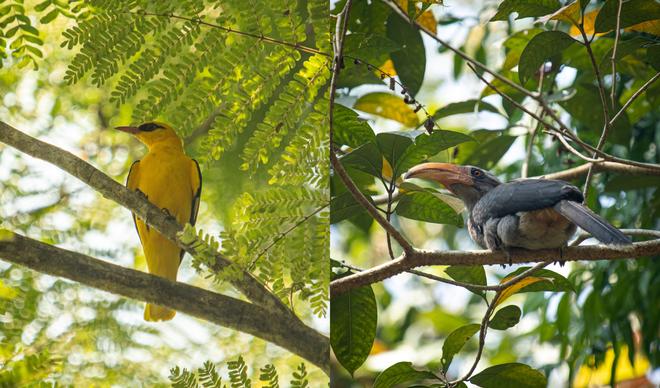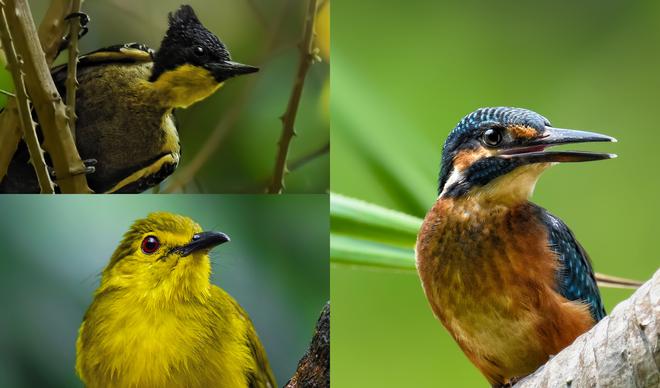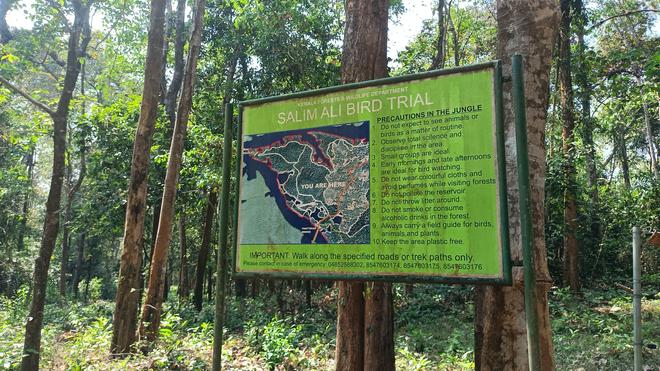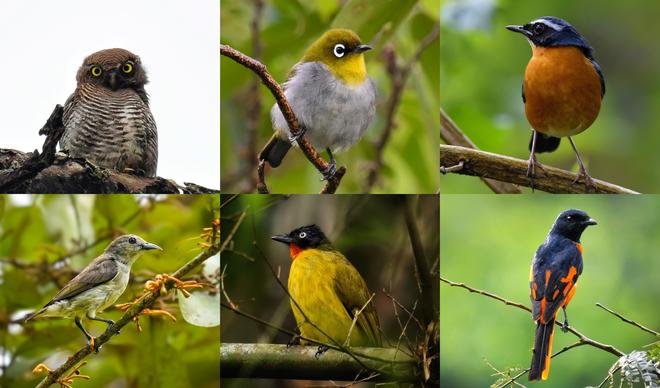Just an hour into the self-guided Salim Ali Nature Trail at the Thattekkad Bird Sanctuary, you feel the sunburn from the scorching heat. The foliage on the footpath is thick and green, the Periyar lake stands still as the sun pierces through the windless sky. Only the cacophony of the wild mynas, orioles, and the occasionally-passing tourist keeps you company. You even wish you had paid more attention to how quickly you finished two litres of water. And yet, if you are an avid birder, it is impossible not to smile as you realise what Dr Salim Ali, the Birdman of India, meant when he called the Thattekkad region “the richest bird habitat in peninsular India, comparable only with the eastern Himalayas.”
Thattekkad Bird Sanctuary is a haven for birds. “You should have come in November or started early today. It does get a bit too hot these days,” says a smiling Sudha Chandran a.k.a Sudhamma, the famous guide at the sanctuary. For over two decades she has seen tourists and birders struggle with the heat.
. Situated in Ernakulam district, about 12 kilometres from Kothamangalam, Thattekkad is one of India’s most popular bird sanctuaries. One of the unique aspects of this 25 sq. km region is how even during the offset of the monsoon, there is no shortage of regional birds — more than 200 species in number, and the flow of visitors.
Thattekkad is one of the rare sanctuaries that attracts birds of local migration and tourists even during the fiery months of April and May. “That is why it’s too early to ascertain how this season has fared when it comes to tourists. People in search of migratory birds may not come, but local tourists and tourists from other states come in these months as well,” says Ouseph, Assistant Wildlife Warden at Thattekad.
Birds of many feathers: A brief guide to bird-watching spots and species in India

But what makes this place special? Ouseph calls to attention the uniqueness of the region where the sanctuary is located. “There is no other place in Kerala that gets so much water. We are truly blessed for the water that flows through the Bhoothathankettu Barrage. The sanctuary is surrounded by reservoirs like Periyar and Periyar Lake in the West; and Idamalayar and Idamalayar Lake in the North.”
Adding to the abundance of water bodies, the forest cover makes it stand out from most other sanctuaries as it brings in both water birds and forest birds to the region, with the latter more in count. “If you see a Ceylon frogmouth, or a Ceylon bay owl, or a Malabar trogon, or the dollarbird, you will be attracted to the sanctuary. Photographers who visit here upload pictures of birds like Ceylon frogmouth, whose guaranteed sight is something truly special,” says Ouseph. “There are three nesting areas and many birders come here especially to get a sight of this frogmouth,” says Agil Jose, a 30-year-old watcher.
This is also why Ajay Henry, a 27-year-old Munnar-based software engineer and bird enthusiast is drawn to Thattekkad. “If you go to the forests near Munnar, you might still come across some species of birds. But you wouldn’t find them regularly visiting those areas,” he says.
When to visit?
Ajay remembers his trip to the sanctuary in August to be memorable, but Agil urges you to consider the first three months of the migratory birding season. “In October, it might rain a lot, which is also not preferable for birding. November and December are perfect; you will see a lot of mist and the place looks beautiful,” says Agil. Whether it is January, March or August, a tourist who wishes to spend a day at Thattekkad is advised to be at the sanctuary by 7am.

How to reach the place?
If you prefer travelling by bike or car and would like a scenic route, take the road from Munnar to Thattekkad leaving around 5.30 am. For those who prefer public transportKothamangalam has the nearest bus stop. “There are frequent buses from Kochi — from Ernakulam South or Kaloor stops — or tourists can even get on a bus at Aluva or Perumbavoor to reach Kothamangalam,” says Ouseph.
Birds you can find in the sanctuary and programmes available for the visitors:
When you visit the sanctuary, you might be tempted to enter through the main entrance of the park, but even the personnel at the ticketing counter would suggest you check out the self-guided Salim Ali Nature Trail, a trail of three kilometres into the forest that is located on the opposite side of the main entrance. If you are an amateur birder who hopes for the trail to be clearly marked, you might want to take a picture of the map at the entrance and note down the emergency contacts just in case. Or if you are like Ajay, who believes that a clearly marked route “takes away the appeal of venturing into the woods, unbeknownst of where to go next,” go on, but remember to take enough water in summer.

The self-guided trail is filled with orioles, mynas, bulbuls, drongos and more. But Ajay suggests you do not spend more than a couple of hours as the true spectacle lies in the bigger forest trail, where you might even spot a king cobra if you are lucky. “Because these professionals know where birds are, and they’d take us only to those areas, it’s worth it. They are very friendly and helpful in spotting birds,” says Ajay. Ouseph advises visitors to pay attention when the guide, at the entrance of the forest, points at the board of do’s and don’ts and explains the points. “We will not tolerate any sort of damage to the ecology, like littering,” he warns.
There are several bird-watching programmes, both free and ticketed, and Ouseph mentions the paid Black baza trail as the most popular. Almost 275 species visit the region. Of these, 16% are migratory birds, like the Black baza bird that migrates from Northeast India and China, and so those who visit the sanctuary from October to March should find these ticketed trails more helpful. “The Black baza programme costs ₹500 per person and a guide with binoculars will take you on a five kilometre trail into the forest. Throughout the three-and-a-half hour trail, the guide will interact and explain the bird and its characteristics,” says Ouseph.
Ouseph hopes one gets a glimpse of the chestnut-winged cuckoo or the white-bellied treepie, which is endemic to the Western Ghats if you are in search of migratory birds.

Those visiting off-season can see close to 150-200 species of birds. The sight of the long-beaked Malabar grey hornbill or the bright yellows of the orioles (three species namely, Indian golden, black-naped and black-hooded) cannot be missed even on a casual walk in the woods. Ajay’s list includes the oriental darter, orange minivet, Nilgiri flowerpecker, Indian blue robin, flame-throated bulbul, heart-spotted woodpecker, Indian white-eye, and the common kingfisher. “Oriental broad-billed dollarbird and Malabar trogon are some other lovely species of birds that come here as well,” says Ouseph.
Being a birdwatching hotspot, the Thattekkad sanctuary also facilitates research and development in the field of Ornithology. “We have bird monitoring centres to study behaviour and tourism. As we speak, a microbiological study is going on in one of the centres. We are treating the region as a learning centre, and all research conducted here is coordinated by this bird monitory centre,” says Ouseph. Also fascinating is the Bird Interpretation Centre, where any enthusiast can take the help of an interpreter to understand birds.
Other special features:

“We have a Butterfly Park and a Children’s Park with several play equipment. Visitors should also try boating in the Periyar River.” Ouseph’s suggestions also include an Animal Rehabilitation Centre and a Medicinal Plants Demo Garden. “The rehab centre is a rescue centre but there are a lot that people can study from there. The Medicinal Plants Demo Garden is a place where almost 200 species of medicinal plants are demonstrated.” A Star Tree Garden that hosts 27 species of trees designated to the 27 nakshatras of ancient Indian astronomy, photo points like the Owl sculpture and a bird nest, and several camping attractions like the Watch Tower and Tree Hut also get regular visitors.
Dr Salim Ali was true when he said even city dwellers can take pleasure in birding, without “going far afield in search of special opportunities,” but that even he couldn’t resist the beauty of Thattekkad says more.







